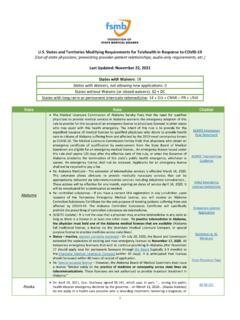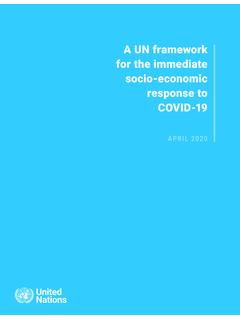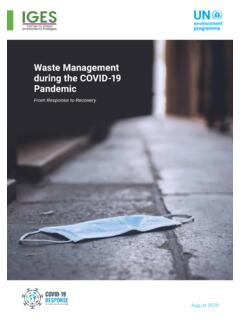Transcription of 2019 Novel Coronavirus (2019‑nCoV): STRATEGIC …
1 2019 Novel Coronavirus (2019 nCoV): STRATEGIC preparedness AND response PLAND raft as of 3 February 2020 World Health Organization 2020 Some rights reserved. This work is available under the Creative Commons Attribution NonCommercialShareAlike IGO licence (CC BY NC SA IGO; nc )Under the terms of this licence, you may copy, redistribute and adapt the work for non commercial purposes, provided the work is appropriately cited, as indicated below. In any use of this work, there should be no suggestion that WHO endorses any specific organization, products or services. The use of the WHO logo is not permitted. If you adapt the work, then you must license your work under the same or equivalent Creative Commons licence. If you create a translation of this work, you should add the following disclaimer along with the suggested citation: This translation was not created by the World Health Organization (WHO).
2 WHO is not responsible for the content or accuracy of this translation. The original English edition shall be the binding and authentic edition .Any mediation relating to disputes arising under the licence shall be conducted in accordance with the mediation rules of the World Intellectual Property designations employed and the presentation of the material in this publication do not imply the expression of any opinion whatsoever on the part of WHO concerning the legal status of any country, territory, city or area or of its authorities, or concerning the delimitation of its frontiers or boundaries. Dotted and dashed lines on maps represent approximate border lines for which there may not yet be full agreement. The mention of specific companies or of certain manufacturers products does not imply that they are endorsed or recommended by WHO in preference to others of a similar nature that are not mentioned.
3 Errors and omissions excepted, the names of proprietary products are distinguished by initial capital letters. All reasonable precautions have been taken by WHO to verify the information contained in this publication. However, the published material is being distributed without warranty of any kind, either expressed or implied. The responsibility for the interpretation and use of the material lies with the reader. In no event shall WHO be liable for damages arising from its in Geneva, photo: THIS DOCUMENT 01 SITUATION ASSESSMENT 03 Epidemiological overview as of 1 February 2020 03 Risk assessment 04 Recommendations of the Emergency Committee 04 response STRATEGY 05A) Rapidly establishing international coordination and operational support 06 Partner coordination 06 Epidemiological analysis and forecasting 07 Risk communication and managing the infodemic 07 Laboratory and diagnostics 07 Technical expertise and guidance 08 Pandemic supply chain coordination 08 Travel and trade 10B) Scaling up country readiness and response operations 11 Country level coordination 12 Risk communication and community engagement 12 Surveillance 12 Points of entry 13 Rapid response teams 13 National laboratory system 13 Infection prevention and control 13 Case management and continuity of essential services 14 Logistics, procurement, and supply management 16C)
4 Accelerating priority research and innovation 17 Enhancing global coordination of all relevant stakeholders 17 Support a clear and transparent global research and innovation priority setting process 17 Build common platforms for standardized processes, protocols and tools, as well as for sharing specimens, data, and information 17 MONITORING FRAMEWORK 19 RESOURCE REQUIREMENTS 21 CONTENTS1 Draft as of 3 February 2020 2019 Novel Coronavirus (2019-nCoV): STRATEGIC preparedness and response PlanOn 31 December 2019, WHO was alerted to a cluster of pneumonia patients in Wuhan City, Hubei Province of China. One week later, on 7 January 2020, Chinese authorities confirmed that they had identified a Novel (new) Coronavirus as the cause of the pneumonia (figure 1). The proposed interim name of the virus is 2019 the first cases were reported, WHO and its partners have been working with Chinese authorities and global experts to learn more about the virus, including how it is transmitted, the populations most at risk, the spectrum of clinical disease, and the most effective ways to detect, interrupt, and contain human to human STRATEGIC preparedness and response plan outlines the public health measures that the international community stands ready to provide to support all countries to prepare for and respond to 2019 nCoV.
5 The document takes what we have learned so far about the virus and translates that knowledge into STRATEGIC action that can guide the efforts of all national and international partners when developing context specific national and regional operational THIS DOCUMENTF igure 1 Timeline of early stages of 2019 nCoV outbreak30/12/2019 Cluster of cases of pneumonia of unknown origin reported in Wuhan to China National Health Commission01/01/2020 Huanan Seafood Wholesale market closed07/01/2020 Novel Coronavirus isolated11/01/2020 First fatal case reported12/01/2020 Whole genome sequence shared with WHO and public; virus designated 2019 nCoV16/01/2020 First case reported in Japan19/01/2020 First case reported in Republic of Korea; two cases in Beijing and one case in Guandong13/01/2020 First case reported from Thailand20/01/2020 First reports of infection in healthcare workers caring for patients with 2019 nCoV24/01/2020835 cases reported in China (549 from Hubei province).
6 Further cases reported from all but one as of 3 February 2020 2019 Novel Coronavirus (2019-nCoV): STRATEGIC preparedness and response Wei3 Draft as of 3 February 2020 2019 Novel Coronavirus (2019-nCoV): STRATEGIC preparedness and response PlanEpidemiological overview as of 1 February 2020 A total of 11953 confirmed cases of 2019 nCoV have been reported worldwide (figure 2); Of the total cases reported, 11821 cases have been reported from China; In China, of all cases since the start of the outbreak have been reported from Hubei Province. The remaining of cases have been reported from 33 provinces, regions, and cities. After Hubei Province, the second largest number of cases has been reported from Zhejiang Province (599 cases); 132 confirmed cases have been reported outside of China in 23 countries (figure 2); Of the cases reported outside China, 14 are due to secondary transmission; 259 deaths have been reported to evidence shows that 2019 nCoV can be transmitted from one individual to another.
7 During previous outbreaks due to other coronaviruses, including Middle East respiratory syndrome Coronavirus (MERS CoV) and the Severe Acute Respiratory Syndrome Coronavirus (SARS CoV), human to human transmission most commonly occurred through droplets, personal contact, and contaminated objects (fomites). The modes of transmission of 2019 nCoV are likely to be precise zoonotic (animal) origin of the 2019 nCoV is still uncertain. The virus has been identified in environmental samples from a live animal market in Wuhan, and some human cases have been epidemiologically linked to this market. Other Coronavirus , such as SARS and MERS, are also zoonotic, and can be transmitted from animals (civet cats and dromedary camels, respectively) to ASSESSMENTF igure 2 Distribution of 2019 nCoV cases as of 01 February 2020 Data Source: World Health Organization, National Health Commission of the People s Republic of ChinaMap Production: WHO Health Emergencies ProgrammeThe boundaries and names shown ans the designations used on this map do not imply the expression of any opinion whatsoever on the part of the World Health Organization concerning the legal status of any country, territory, city or area or of its authorities, or concerning the delimitation of its frontiers or boundaries.
8 Dotted and dashed lines on maps represent approximate border lines for which there may not yet be full agreement. World Health Organization 2020, All rights as of 3 February 2020 2019 Novel Coronavirus (2019-nCoV): STRATEGIC preparedness and response PlanRisk assessmentWHO assesses the risk to be very high for China, high at the regional level, and high at the global taken into consideration include: Likelihood of further spread: Human to human transmission, including transmission within families and healthcare settings, has been confirmed within Wuhan, and in several cities outside China. The outbreak continues to grow within China at a rapid rate, and now affects all 31 provincial level administrative regions. Ordinarily high volumes of domestic and international travel have been increased further by travel linked to Lunar New Year celebrations. Imported cases continue to be reported internationally, with several reported cases of secondary transmission now confirmed in countries outside of China.
9 Limited testing capacity in many countries globally, non specific symptoms of 2019 nCoV acute respiratory disease (the disease caused by 2019 nCoV infection), and co circulation of other respiratory pathogens are factors that can complicate efforts to detect the virus quickly. Potential impact on human health: The virus can cause severe illness and death, although most cases appear to be mild. However, many uncertainties remain, including the full extent of the current outbreak within China, and the full clinical spectrum of illness, including the prevalence of mildly symptomatic cases. Effectiveness of current preparedness and response measures: China has dedicated substantial resources to public health control measures and clinical management, and has taken action that has included the quarantine of cities, and the widespread suspension of transport links between population centres. It will be important to continually assess the extent to which measures are effective and the need to adapt measures as the situation evolves.
10 Up to now, countries that have reported an imported case have demonstrated efficient and effective disease surveillance and response measures. However, some countries are less prepared to detect and respond to an imported case. Rumours, misconceptions, and misinformation disseminated online via social media can have a negative impact on response measures and health seeking of the Emergency CommitteeOn 30 January 2020, the Director General of WHO declared the 2019 nCoV outbreak a public health emergency of international concern under the International Health Regulations (IHR) (2005), following advice from the Emergency Committee. The Director General and Emergency Committee issued temporary recommendations1 to the People s Republic of China and to other Emergency Committee also provided advice to WHO, and welcomed a forthcoming WHO led multidisciplinary and multi partner technical mission to China.

















